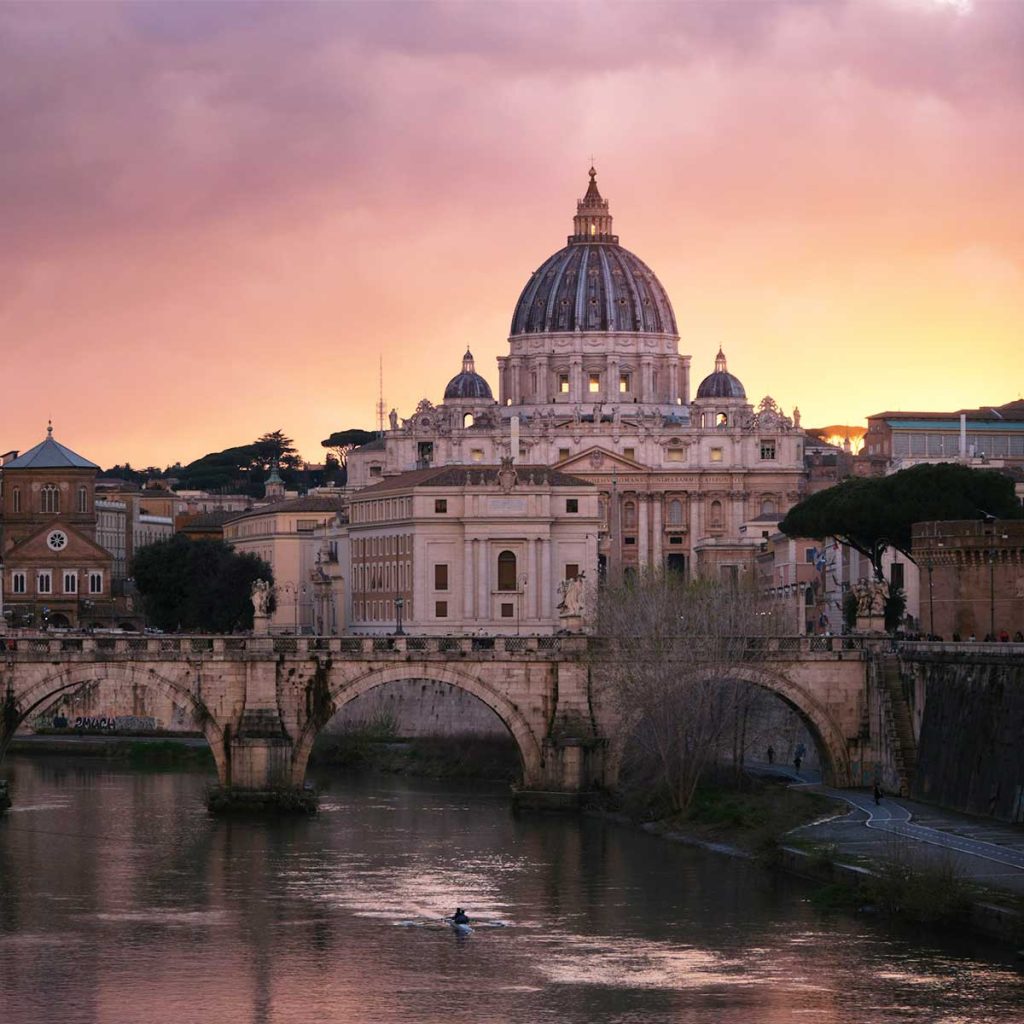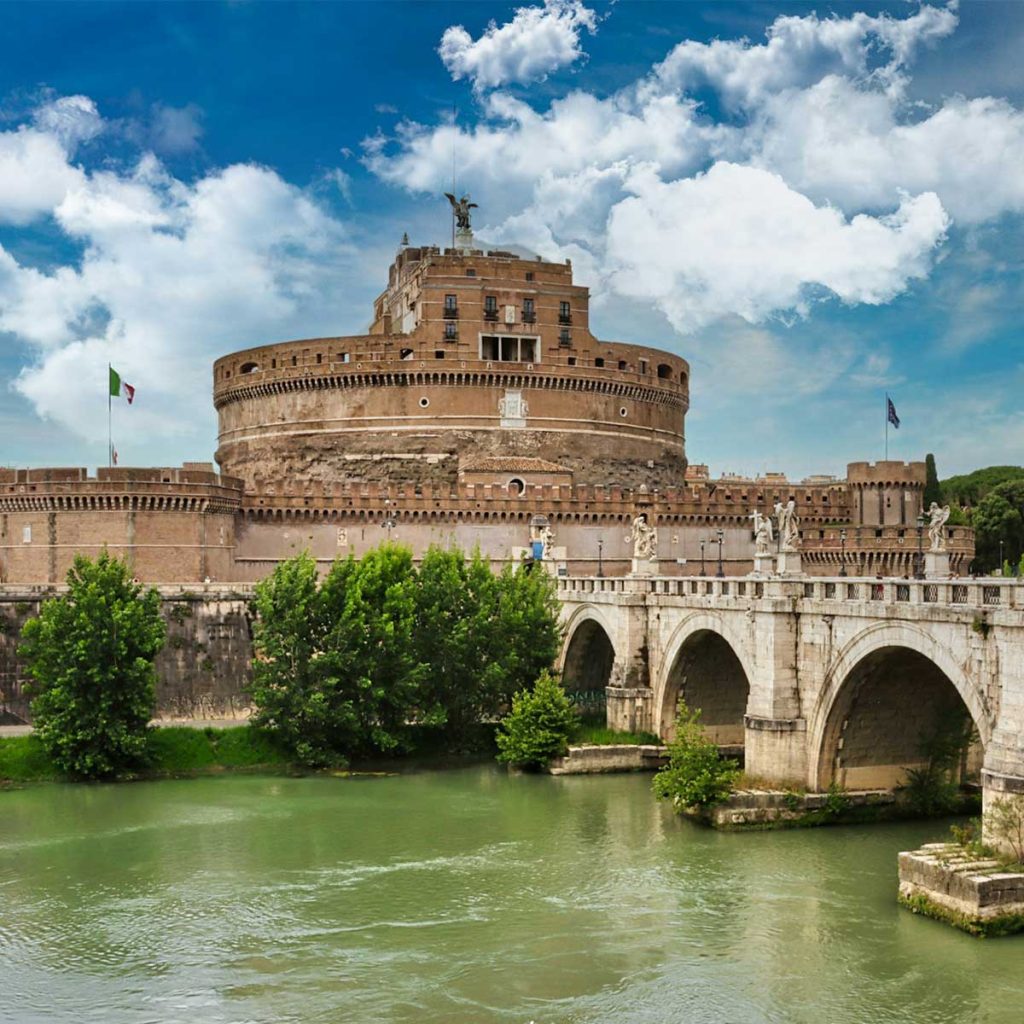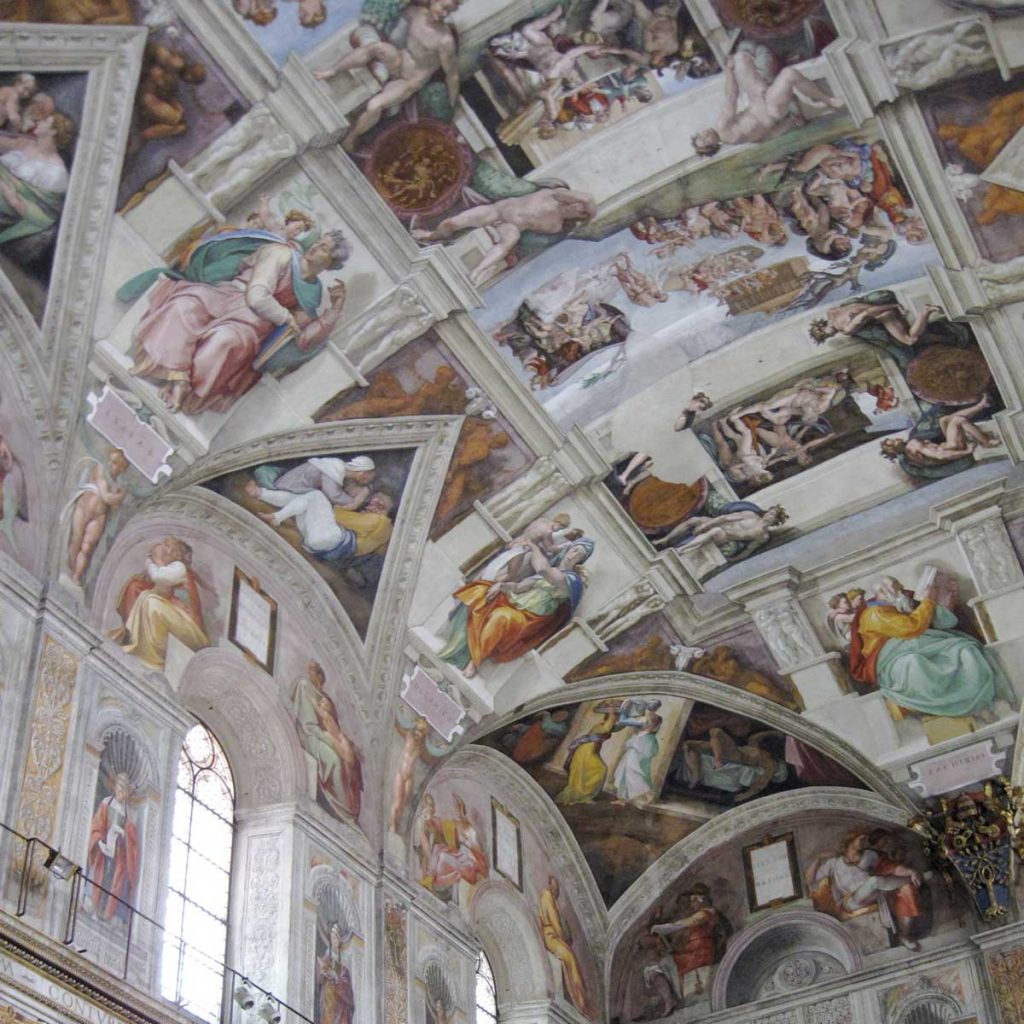Must-see nearby
in the beating heart of the Eternal City
at a stone’s throw from the most dreamed-of masterpieces
Our neighbours? True marvels.
After satisfying the appetite, the eye also wants its share. Satiricus is located in a privileged position: in the historic center of Rome, but outside the restricted traffic area. It is located in the pulsating heart of the Eternal City, next to the most famous attractions of the Capital, literally a stone’s throw away from the most sought-after masterpieces by tourists from all over the world. From our outdoor space, you can enjoy a splendid view of the colonnade of St. Peter’s, in the heart of Borgo Pio, while immortal masterpieces such as Castel Sant’Angelo and the Sistine Chapel are only a few hundred meters away.

the basilica and colonnades
Saint Peter
St. Peter’s Square is the symbol of an area that will leave you breathless. The majestic building of St. Peter’s Basilica in the Vatican is characterized by the semicircular baroque colonnades on the sides, designed by Gian Lorenzo Bernini, which ideally embrace visitors from all over the world in a great hug. On one side of the colonnade there are the security offices for entry into St. Peter’s, and on the other side is the Vatican post office which, as an autonomous state, has its own coins and stamps.
The tradition states that the Basilica stands exactly over the tomb of the apostle Peter, who was crucified around 60 A.D. During the reign of Constantine, when Christianity was recognized as the official religion of the empire, construction began on the basilica, lasting 11 years. Only in 1506 did Pope Julius II decide to build a new cathedral, entrusting Bramante with its construction.
The old Basilica was destroyed, and it took over 100 years to see completed what in the intentions of the pope was to be the largest cathedral of Christianity. Today St. Peter’s is a cathedral 130 meters high, 190 meters long and containing some of the most famous works in the world: from Michelangelo’s Pieta to Bernini’s Baldacchino. Here the faithful from all over the world gather for the Angelus and the Pope’s mass, but also for the funeral vigils related to the deaths of the popes, their funerals and the elections.

THE BASILICA AND COLONNADES
Saint Peter
St. Peter’s Square is the symbol of an area that will leave you breathless. The majestic building of St. Peter’s Basilica in the Vatican is characterized by the semicircular baroque colonnades on the sides, designed by Gian Lorenzo Bernini, which ideally embrace visitors from all over the world in a great hug. On one side of the colonnade there are the security offices for entry into St. Peter’s, and on the other side is the Vatican post office which, as an autonomous state, has its own coins and stamps.
The tradition states that the Basilica stands exactly over the tomb of the apostle Peter, who was crucified around 60 A.D. During the reign of Constantine, when Christianity was recognized as the official religion of the empire, construction began on the basilica, lasting 11 years. Only in 1506 did Pope Julius II decide to build a new cathedral, entrusting Bramante with its construction.
The old Basilica was destroyed, and it took over 100 years to see completed what in the intentions of the pope was to be the largest cathedral of Christianity. Today St. Peter’s is a cathedral 130 meters high, 190 meters long and containing some of the most famous works in the world: from Michelangelo’s Pieta to Bernini’s Baldacchino. Here the faithful from all over the world gather for the Angelus and the Pope’s mass, but also for the funeral vigils related to the deaths of the popes, their funerals and the elections.
Useful information
Saint Peter’s is open every day from 7.00 am to 6.30 pm (during the summer season until 7.00 pm). Is a reservation required? No, the visit is free and will take at least a couple of hours. How much does it cost? Entrance to the Basilica is free. However, you can climb the 231 steps to the roof of St. Peter’s Basilica on foot or take the elevator. Entrance with stairs costs 8 euros, with the elevator 10 euros.
the castle and walkway
Castel Sant'Angelo and Passetto
If you find yourself in Rome, in the Lungo Tevere Castello area, it would be an unforgivable sin not to walk towards the splendid Angels Bridge to visit the famous Hadrian’s Mausoleum, better known, by Romans and non-Romans, as Castel Sant’Angelo. Walking through the corridors of the 7 different levels of the castle means embarking on a journey of over 2000 years. From ancient Rome (125 A.D), when Castel Sant’Angelo was the mausoleum of Emperor Hadrian, to its medieval use as a fortress to defend the city from external attacks, to the lavish papal apartments of the Renaissance, to the museum of today.
Since a few years ago, it is once again possible to walk along the “Passetto di Borgo”, the famous walkway that connects the castle to the Vatican Palaces, used over the centuries to facilitate the passage of the popes to their private apartments but above all to ensure an escape route in case of danger. Along with the Passetto, you can visit the historic prisons, the Oliare, the rooms once used as food storage, the courtyard of Leo X, the room called ‘del Forno’ and the tiny Stufetta of Clement VII, famous for the frescoes from the workshop of Raphael. A little gem? Since July 2014, entrance is free on the first Sunday of every month.

the castle and walkway
CASTEL SANT'ANGELO AND PASSETTO
If you find yourself in Rome, in the Lungo Tevere Castello area, it would be an unforgivable sin not to walk towards the splendid Angels Bridge to visit the famous Hadrian’s Mausoleum, better known, by Romans and non-Romans, as Castel Sant’Angelo. Walking through the corridors of the 7 different levels of the castle means embarking on a journey of over 2000 years. From ancient Rome (125 A.D), when Castel Sant’Angelo was the mausoleum of Emperor Hadrian, to its medieval use as a fortress to defend the city from external attacks, to the lavish papal apartments of the Renaissance, to the museum of today.
Since a few years ago, it is once again possible to walk along the “Passetto di Borgo”, the famous walkway that connects the castle to the Vatican Palaces, used over the centuries to facilitate the passage of the popes to their private apartments but above all to ensure an escape route in case of danger. Along with the Passetto, you can visit the historic prisons, the Oliare, the rooms once used as food storage, the courtyard of Leo X, the room called ‘del Forno’ and the tiny Stufetta of Clement VII, famous for the frescoes from the workshop of Raphael. A little gem? Since July 2014, entrance is free on the first Sunday of every month.

Useful information
Translation: Castel Sant’Angelo is open every day from 9:00 to 19:30. Is a reservation required? It depends, it costs 1 euro and is recommended for groups of more than 20 people and for schools, but optional for individuals. How much does it cost? Full price: 14 euros Reduced (between 18 and 25 years old): 7 euros.

The collection and chapel
Vatican Museums and Sistine Chapel
The Sistine Chapel is universally considered the heart of the Apostolic Palaces, one of the most extraordinary pictorial works ever conceived by man, and probably the pinnacle of Western art production. The room in which the Holy Spirit inspires the name of each Pontiff to the Conclave will leave you breathless not only thanks to the back wall, the Universal Judgment work of the genius of Michelangelo, but also with the other “paintings” signed on the other three sides by Botticelli, Perugino, and Ghirlandaio.
It is the beating heart of the Roman Catholic Church, a true sanctuary that every human being should visit at least once in their life. The Sistine Chapel is included in an ideal tour that also includes the Gardens and the Vatican Museums, and it is precisely these last that represent a must-see for every tourist visiting the Eternal City. Here is preserved one of the most incredible art collections in the world, an unmatched ensemble of works accumulated by the popes over the centuries (consider that the total value of the works is around 15 billion euros).
The works of art and sculptures are displayed over an area of more than 14 kilometers, spanning different historical periods from ancient Egypt to the 20th century. Immerse yourself in the timeless beauty of the Renaissance masters’ works: Raphael’s masterpieces in the eponymous Rooms, which served as the entrance to the papal apartment, and Michelangelo’s works in other rooms. Do not miss the portraits of past popes, the Round Room, and the impressive Gallery of Statues. A little gem? By clicking here, you can find all the useful information to organize your tour from home, avoiding the long lines for tickets that you would otherwise have to face to enjoy the magnificence of the museums.

THE COLLECTION AND CHAPEL
VATICAN MUSEUMS AND SISTINE CHAPEL
The Sistine Chapel is universally considered the heart of the Apostolic Palaces, one of the most extraordinary pictorial works ever conceived by man, and probably the pinnacle of Western art production. The room in which the Holy Spirit inspires the name of each Pontiff to the Conclave will leave you breathless not only thanks to the back wall, the Universal Judgment work of the genius of Michelangelo, but also with the other “paintings” signed on the other three sides by Botticelli, Perugino, and Ghirlandaio.
It is the beating heart of the Roman Catholic Church, a true sanctuary that every human being should visit at least once in their life. The Sistine Chapel is included in an ideal tour that also includes the Gardens and the Vatican Museums, and it is precisely these last that represent a must-see for every tourist visiting the Eternal City. Here is preserved one of the most incredible art collections in the world, an unmatched ensemble of works accumulated by the popes over the centuries (consider that the total value of the works is around 15 billion euros).
The works of art and sculptures are displayed over an area of more than 14 kilometers, spanning different historical periods from ancient Egypt to the 20th century. Immerse yourself in the timeless beauty of the Renaissance masters’ works: Raphael’s masterpieces in the eponymous Rooms, which served as the entrance to the papal apartment, and Michelangelo’s works in other rooms. Do not miss the portraits of past popes, the Round Room, and the impressive Gallery of Statues. A little gem? By clicking here, you can find all the useful information to organize your tour from home, avoiding the long lines for tickets that you would otherwise have to face to enjoy the magnificence of the museums.
USEFUL INFORMATION
